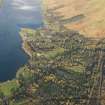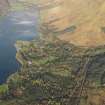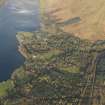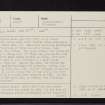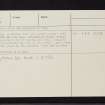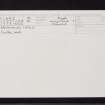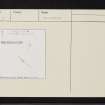Ardkinglas Castle
Castle (Medieval)
Site Name Ardkinglas Castle
Classification Castle (Medieval)
Alternative Name(s) Ardkinglas House Policies
Canmore ID 23628
Site Number NN11SE 2
NGR NN 175 102
NGR Description NN c. 175 102
Datum OSGB36 - NGR
Permalink http://canmore.org.uk/site/23628
- Council Argyll And Bute
- Parish Lochgoilhead And Kilmorich
- Former Region Strathclyde
- Former District Argyll And Bute
- Former County Argyll
NN11SE 2 1777 1055 and 1778 1055
For list of related sites see NN11SE 21 Ardkinglas House.
Destroyed 1769.
(Undated) information in NMRS.
Ardkinglas House (NN 1752 1038) is of recent construction, having been built shortly after Ardkinglas Castle was burnt down (Name Book 1870). The New Statistical Account [NSA] (1845) describes Ardkinglas Castle as "composed of three separate towers, each fronting an area within. The space between the towers is defended by a strong wall 15' high; the gate in the wall is defended by small round turrets in flank, with shotholes. The gate is also defended by a small tower immediately above it. Around the area, and within the walls, are smaller buildings for servants, stores, etc. The castle is built in a low, and not strongly defensive, position. It is not known when it was built, but there is evidence of it having been repaired in 1586. It was burnt down a few years ago, as workmen were finishing extensive repairs."
NSA (written by J M'Dougal) 1845; Name Book 1870.
Ardkinglas House: Built 1906-8 for Sir Andrew Noble, who acquired the estate in 1905. On the site of medieval Ardkinglas Castle (stronghold of the Campbells of Ardkinglas) which was destroyed in 1769.
HBD No. 11 [undated]
NN 1778 1055. A massive well 4.0m square within a wall c. 3.0m thick and 4.0m deep, situated on a stony moraine with what appears to be the remains of a wall alongside to the E, may indicate the site of the castle. Apart from some hummocky ground in the vicinity, there are no other remains.
Well surveyed at 1:2500.
Visited by OS (D W R) 7 March 1973.
Field Visit (June 1988)
Ardkinglas was the seat of an important branch of the Campbell family, descended from Colin, son of Colin Campbell of Lochawe, who probably received the extensive estate, lying between Loch Fyne and Loch Long, at about thetime of his marriage in 1396 (en.1*). The old castle [NN11SE 2] is indicated on an estate-plan of 1790 showing James Playfair's proposed house and offices (see No.l49), and it was also described in the Statistical Account published two years later (en.2). Playfair's caption indicated 'the Castle to be left in part as a ruin, and will be Gardener's house and hovell for Cattle', but it had been demolished before Garnett's visit in 1798 (en.3).
As shown on Playfair's plan, the castle appears to have been situated about 150m S of the present Ardkinglas House, on a level triangular area at the junction of three estate-roads or in the field immediately to the NE. In 1790 it lay between two small streams, which converged l00m to the WNW, but that to the N is no longer visible. The building is shown as an enclosure, about 30m square, with circular towers at all but the Wangle, and a gatehouse of considerable projection at the centre of the SW wall. This corresponds well with the contemporary description of the castle as being 'composed of three separate towers, each of them fronting an area within. The space, between the towers, is defended by a strong wall, about 15 feet (4.6m) high. In the course of this wall is the great gate, which is defended by small round turrets in flank, with apertures, through which those who assailed the gate might be annoyed with arrows, or with small fire-arms. The gate is also defended by a small tower, immediately above it, called the gate tower. Around the area, and within the walls, are smaller buildings, for lodging servants, for holding arms, and for storehouses and cellars'. The writer adds, presumably on the basis of a datestone, that 'there is certain evidence of its having been repaired in the year 1586' but no carved fragments from the building are known to survive.
The same account states that 'the old residence of the family of Ardkinglass, of which the ruins can now scarcely be traced, was at a small distance from the present castle, but in a more commanding situation' [NN11SE 8]. It is possible that this is to be associated with a massive stone-lined well about 4msquare and 4m deep, on the summit of a glacial ridge 400mto the NNE (NN 177105) (en.4*), but no remains of a defensive character are now identifiable.
RCAHMS 1992, visited June 1988












